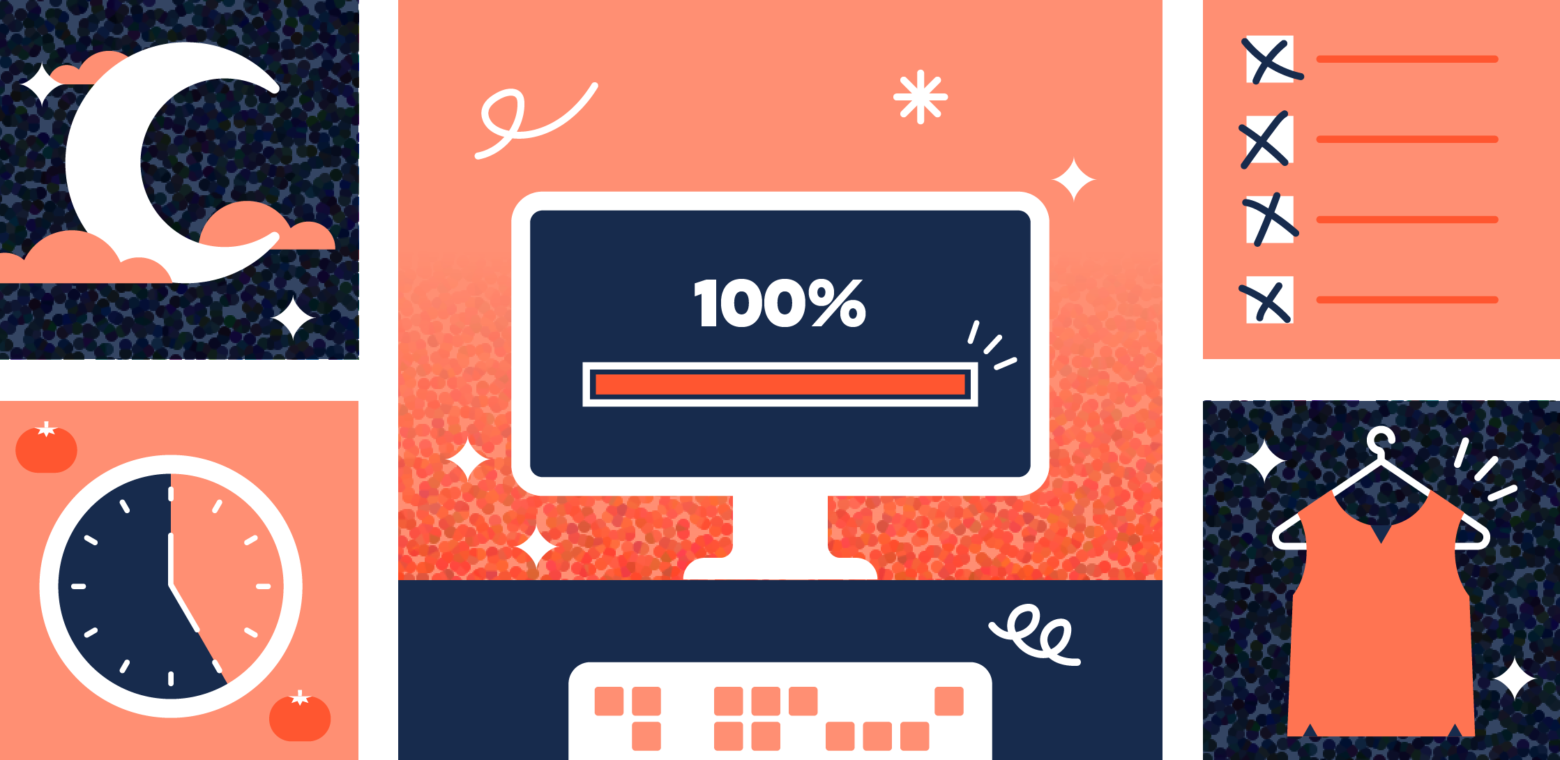5-second summary
- Many of us have made a permanent transition to remote work, but some still struggle to stay productive while maintaining healthy work-life boundaries.
- Try a few (or all!) of our nine science-backed tips for boosting productivity when you’re working remotely.
- Then, take our quiz to discover which productivity hack you should try.
The persistence of remote work is no longer up for debate. Many of us have made a permanent switch to a work-at-home lifestyle, forgoing the built-in parameters of office life that used to regulate our productivity – with mixed success.
A major global study into remote working, conducted by Paper Giant for Atlassian, found that 40% of respondents felt that working from home translated to significantly longer hours.
But it doesn’t have to be that way. As we continue to move away from traditional office spaces, in the face of the COVID-19 pandemic and beyond, remote workers can deploy a number of hacks and tricks to boost productivity. The goal? To hit all of your targets without impinging on your wellness or work-life balance. Read on for our nine science-backed, expert-approved principles of self-productivity.
1. Master desk-scaping
The Paper Giant study found that 49% of workers felt they needed a better working space if they were to continue working from home – with more than a third (34%) saying their workspace was less comfortable than the office. The solution? Stop shuffling piles of paper and get desk-scaping.
A recent report published by the Journal of Neuroscience proved that clutter limits the brain’s ability to process information correctly. So, if you want to start completing tasks more efficiently, it’s time to get tidying.
First, try “zoning” your home office, by creating separate spaces for reference materials, supplies, and long-term projects, before assigning discard dates to as many as possible. Then clear the desk itself and only replace items that are essential for your day-to-day work.
Finally, add pops of color wherever you can – a picture on the wall, a screensaver, or even your favorite mug. Color can have a major impact on mood, with greens and blues shown to increase productivity, so reach for that ocean vista or add a leafy plant to the proceedings. (As well as their greenness, a study from Washington State University found that plants have additional benefits in terms of inspiring productivity).
2. Embrace mono-tasking
The brutal truth is that very, very few of us can efficiently multi-task. In fact, it’s roughly 2% of the population, according to Professor David Strayer of the University of Utah, an expert in cognitive distraction. The problem is that when we bounce from task to task, we aren’t actually getting more done. Instead, we’re forcing our brains to constantly switch speeds, steering through tasks more erratically and burning out our internal gearboxes. The answer is to slay the multi-tasking monster, and embrace mono-tasking.
“We’ve been sold the myth that multi-tasking is a valuable skill, giving us the ability to get it all done – but this couldn’t be further from the truth,” says business coach Ryan Jackson, author of “The Success Rebellion.”
“A more productive approach is to devote days or half-days to themes, or closely related tasks,” he explains. “That way, it’s easier to knock jobs down one at a time and even if you do get distracted, it’s quicker to pick up the thread again.”
3. Plan tomorrow, tonight
The Paper Giant study discovered that 44% of workers believe it’s now more important to know how to motivate themselves apart from the parameters of office life. One of the best ways to do that is with a to-do list – and the best time to make that list is the night before.
While you’re still in work mode, take the final 10 minutes of your day to assess what you really need to get done tomorrow – a task that could take twice as long when coming to it cold first thing in the morning. The key is to keep your list short so it doesn’t seem overwhelming. According to Niamh Graham, head of Global HR at Workhuman, the Urgent-Important Matrix is a great way to do that.
“Otherwise known as the Eisenhower Matrix, this is an excellent tool to help prioritize tasks, especially when working from home,” says Graham. “The matrix helps you organize tasks into four quadrants by urgency and importance.” Then you can hone straight in on the ‘Urgent-Important’ tasks and schedule, delegate, or eliminate the others.
4. Make a not-to-do list
So you’ve made your to-do list, but to maximize your healthy habits, you’ll need the opposite, too. A not-to-do list should be a permanent addition to your workspace, featuring all of the distractions you want to avoid during the workday – think social media, cat videos, a sink full of dishes.
“Without the prospect of your boss loitering behind you, even the most disciplined workers are susceptible to the temptation of time-wasting,” says Jackson. “Creating a [forbidden] list helps remind you what to avoid, while actually blocking yourself from certain websites during the working day will help you even more.”
To make this easier, check out apps like RescueTime, LeechBlock, or SelfControl that you can configure to prevent access to selected websites during certain time periods.
5. Block out your productive “flow” times
Your “flow” time is when you’re most efficient: a period of hyper-focus when you work most smoothly. For some people, it’s early in the morning, while for others it’s the afternoon or evening. Once you’ve identified yours, block out 90 minutes in that window each day for pure, deep work on your biggest tasks.
“Deep work needs to be performed in a state of distraction-free concentration and is important because without it, you’ll find yourself constantly focusing on small, non-value adding tasks and never making progress on your bigger, more important pieces of work,” says certified high performance coach David Grieve. “Blocking out time is a great way to ensure this crucial period happens every day, without any rings or pings to distract you.”
6. Prioritize Pareto and Pomodoros
Named after Italian economist Vilfredo Pareto, the Pareto Principle (also known as the 80-20 Rule) states that 80% of your results come from 20% of your actions, and vice versa. In other words, to become more productive, you must identify the 20% of your work that is having that 80% impact, and always prioritize it.
Next, you should maximize your minutes spent working on that crucial 20% via the Pomodoro Technique – a series of 25-minute “sprints” spent focusing on a task, each followed by a five-minute break.
“The level of our concentration is deeply affected by our mental stamina,” says Grieve. “Pomodoros and Pareto are two techniques that can help us manage our time more effectively – as is the Getting Things Done (GTD) method by David Allen.”
7. Learn to nap like a pro
Unless you’re looking for an excuse to get fired, napping isn’t an option in a traditional workplace – but it’s a strategy you can use to your advantage when working remotely. The secret is to harness your body’s natural circadian rhythm and employ a 20-minute power nap (sometimes called a Stage 2 Nap) in the mid-afternoon, to boost your memory, cognitive skills, and creativity.
By restricting yourself to just 20 minutes, you reap the aforementioned benefits without falling into deeper REM sleep, which would leave you feeling groggy and disoriented. To maximize productivity, drink a cup of coffee immediately before your power nap. Researchers have found that caffeine takes about 20 minutes to manifest its physiological effect, so it will kick in just as you’re waking.
8. Dress for success
When you’re working from home, it doesn’t really matter how you dress – but making some sartorial effort can have a positive effect on your productivity levels. Take advantage of the time you save from not commuting and establish a morning routine that prepares you for the day ahead – including the selection of slightly smarter clothing, which sends a message to your brain that it’s game time, sparking a bit more mental energy.
“Dressing appropriately switches your work mindset to ‘on,’ which is crucial for concentration levels and will give you a sense of added purpose,” says leading business and innovation expert Erica Wolfe-Murray, author of Simple Tips Smart Ideas: Build a Bigger Better Business. That doesn’t mean you have to wear a pencil skirt or three-piece suit while you work from your guest room. But it does mean you should leave the sweat pants in the wardrobe on work days.
9. Set up a “force quit” to your work day
Elite athletes know that rest is as important as training when it comes to optimal performance – and if you want to be more productive, you need to learn that lesson, too. When you’re working from home, it’s easy to let tasks drift into the evening, but that can be problematic – not only for your personal life, but for your output the following day, too. (The Paper Giant survey found many workers were beginning to resent the ways work is “colonizing” their home lives).
“Overworking can lead to stress and burnout, harming not only your productivity but also your overall mental health and wellbeing,” says Graham. “Instead, set a firm time to bring your workday to a close and stick to it at all costs.” If you struggle with this, find an accountability partner – a colleague, friend, or manager – and set up a call to officially end the day. A hard finish not only means a softer start to the following morning after a good rest, but also that you’ll work faster and more efficiently each day, knowing that your finish time is non-negotiable.
Put these tips to work right now
Want to get the most out of the advice in this article? Pick two tips and implement them right now. Or, step through this short quiz if you need some more direction.
And then, if it happens to be the end of the day where you are, call it a night and start fresh in the morning. Tip #9 makes good sense, right?





 )
) 







































